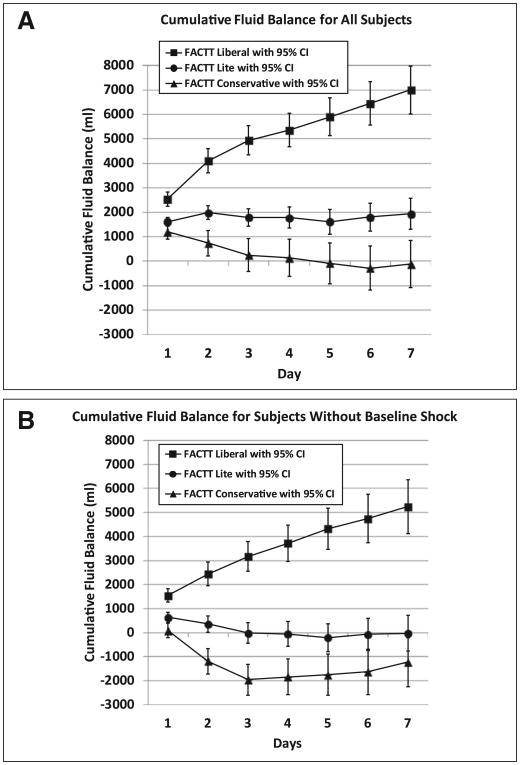Figure 1.
A, Cumulative fluid balance for all subjects: Cumulative fluid balance over study days 1 to 7 for the three cohorts. The conservative and liberal fluid protocol groups are from the Fluid and Catheter Treatment Trial (FACTT) of the Acute Respiratory Distress Syndrome (ARDS) Network and are referred to as “FACTT Conservative” and “FACTT Liberal.” The FACTT Lite group is from subsequent ARDS Network studies that used a simplified fluid conservative protocol. Both the FACTT Conservative and FACTT Lite groups had significantly less cumulative fluid balance compared with the FACTT Liberal group (p < 0.001). The FACTT Lite group had significantly greater cumulative fluid balance over 7 days compared with the FACTT Conservative group (p < 0.001). The error bars indicate 95% CIs for cumulative fluid balance on each study day for each group. The number of subjects included in the analysis for each day for the FACTT Conservative and Liberal groups was previously reported (1). The number of subjects included in the analysis for each day for the FACTT Lite group is as follows: n = 1,120 (day 1), n = 1,102 (day 2), n = 1,069 (day 3), n = 1,008 (day 4), n = 921 (day 5), n = 846 (day 6), and n = 773 (day 7). B, Cumulative fluid balance for subjects without baseline shock: Cumulative fluid balance over study days 1 to 7 is shown for subjects without baseline shock in each of the groups. Both the FACTT Conservative and FACTT Lite groups without baseline shock had significantly less cumulative fluid balance compared with the FACTT Liberal group without baseline shock (p < 0.001). The FACTT Lite group had a similar cumulative fluid balance over 7 days compared with the FACTT Conservative group (p = 0.06). The error bars indicate 95% CIs for cumulative fluid balance on each study day for each group.

